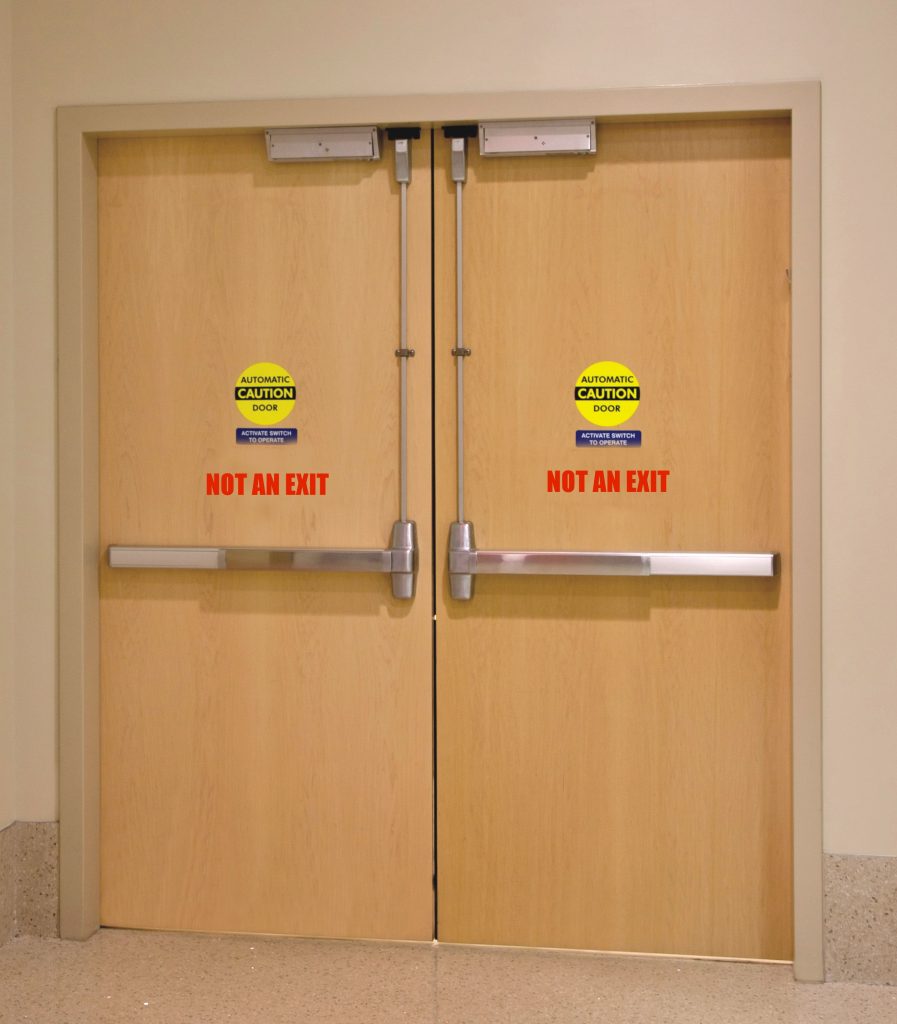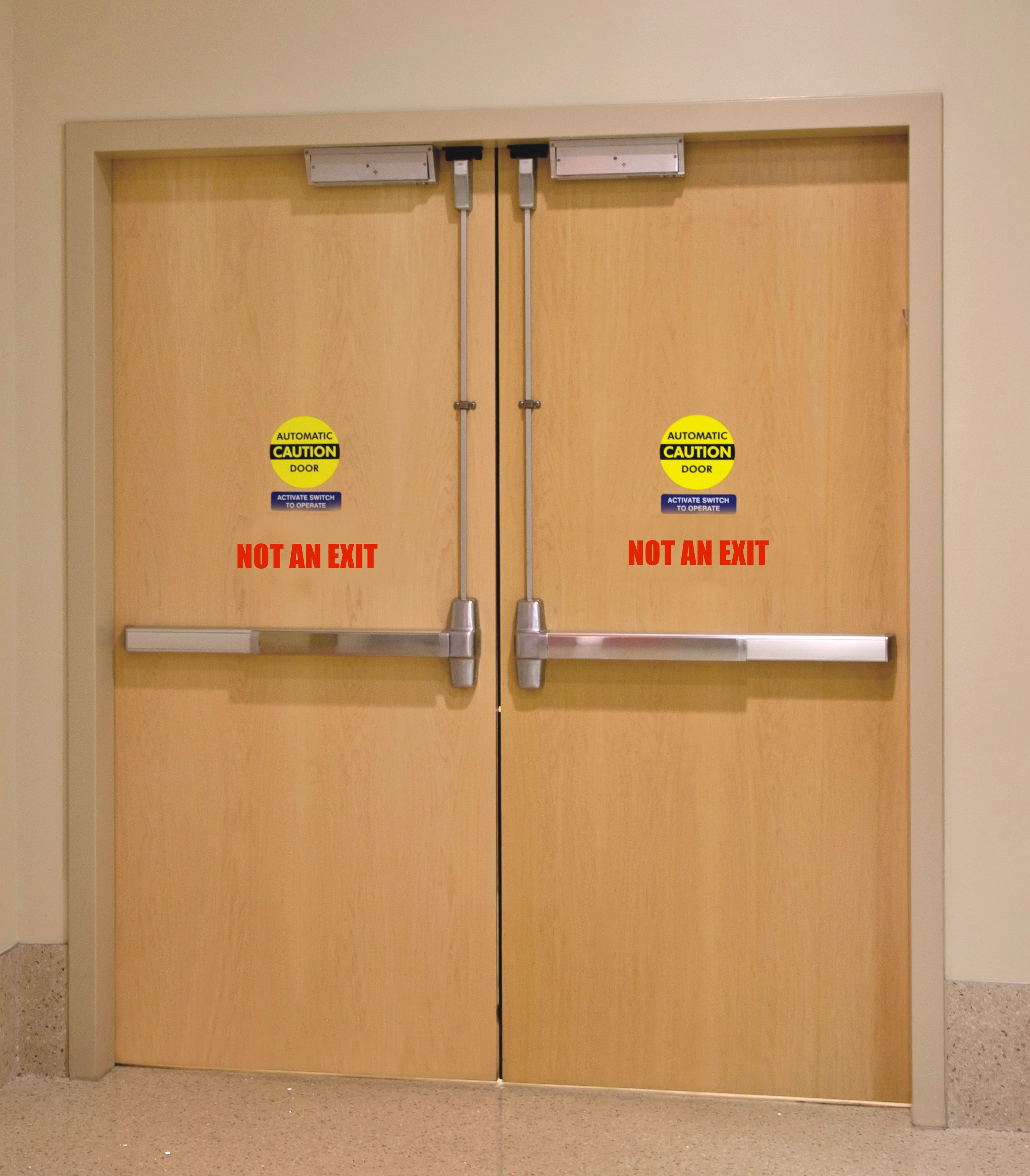 Panic hardware is usually installed on outswinging doors, because it is typically used when there is an occupant load that requires doors which swing in the direction of egress. In almost all cases, these doors are in the path of egress that eventually leads to the exit discharge. But – is it acceptable to install panic hardware on inswinging doors?
Panic hardware is usually installed on outswinging doors, because it is typically used when there is an occupant load that requires doors which swing in the direction of egress. In almost all cases, these doors are in the path of egress that eventually leads to the exit discharge. But – is it acceptable to install panic hardware on inswinging doors?
There is one such application that comes up quite often, where fire exit hardware (panic hardware for fire doors) might be desired. When an operating room in a health care facility has a pair of inswinging doors that are fire-rated with automatic operators, fire exit hardware is the least problematic way of latching the doors. I have also received this question relative to other inswinging applications where electric latch retraction hardware is desired.
I have scoured the model codes and I have not found a prohibition on panic hardware installed on inswinging doors or doors that do not lead to an exit. Of course, the Authority Having Jurisdiction (AHJ) may not allow this application if he/she feels that the panic hardware creates a hazardous situation.
When the doors are used in an area of “trained traffic,” like an operating room, it is less likely that someone will mistake the doors for an egress route. To avoid confusion, the AHJ may require the doors to be clearly marked “Not an Exit” or “No Exit.” NFPA 101, OSHA, and the International Fire Code all have provisions for identification of doors that look similar to exits, but are not part of a means of egress. For example, the OSHA regulations state: “1910.37(b)(5) –Each doorway or passage along an exit access that could be mistaken for an exit must be marked “Not an Exit” or similar designation, or be identified by a sign indicating its actual use (e.g., closet).”
Keep in mind, because the issue of panic hardware on non-exit doors is not specifically addressed by the model codes, the interpretation will be up to the AHJ. If you have ever dealt with this application, I’d love to hear about it. Was the panic hardware allowed or prohibited? Was signage required on the door, or was there another means of avoiding confusion?
UPDATE: When I asked for AHJ feedback on this application, two AHJs thought panic hardware on an inswinging door would be ok but might require signage depending on the application. Another pointed out that the definition of panic hardware per the IBC is: “A door-latching assembly incorporating a device that releases the latch upon the application of a force in the direction of egress travel.” Panic hardware does release the latch when a force is applied in the direction of egress travel (a hospital latch on the push side of the door does too), but I would not have interpreted the definition to mean that a panic can only be used on the egress side of a door. Like I said above…this one will be up to the AHJ’s interpretation.
Got a QQ (Quick Question)? If you can’t find the answer on iDigHardware, drop me an email!
You need to login or register to bookmark/favorite this content.






I do not see a problem with it.
It is a releasing device to open the door. If there was a lever type device, I do not think people would consider it an exit. Yes possibly some may consider a door with panic hardware to be an exit.
But with no exit sign above the door, people may just walk by it??
It might be a case by case, if extra signage is needed.
On an OR door, I see no difference between an exit device and a push-paddle latchset. Those doors need to be opened by pushing on the operating hardware with body parts other than the freshly scrubbed hands of the personnel using that room.
Lori,
I would not allow it.
My understanding is (as you mentioned from the IBC) that an Exit Device is made for Means of Egress.
I feel that people would try to use it in time of Panic.
In only some very rare scenario should someone need Panic Hardware when not needed for Egress.
Latch Retraction can be substituted with Elec Strike. Even when Fire Rated and Fail Safe is Required, they can have a Fail Secure Strike and a Fail Safe Lock.
Lori:
We have used this application on hospital OR doors in our area. It hasn’t been an issue. I don’t know it they had
to add “not an exit” sign.
As you said, this is in an area of trained personnel and they know where the exit doors are.
On paired openings we like 2 exit devices so we aren’t dealing with flush bolts.
The building codes identify the requirements (how & what) for panic hardware and their scope (where). Since the codes do not indicate where panic hardware CANNOT be utilized, panic hardware can be used ANYWHERE as long as they does not conflict with other code requirements.
Lori – thanks for posting. The 2012 edition of NFPA 101, section 4.6.12.3*, states “Existing life safety features obvious to the public, if not required by the Code, shall be either maintained or removed.” Then in Annex A, it goes on to say “The presence of a life safety feature, such as sprinklers or fire alarm devices, creates a reasonable expectation by the public that these safety features are functional. When systems are inoperable or taken out of service but the devices remain, they present a false sense of safety.” From reading this, in my opinion the question would be – would your AHJ consider the specific panic hardware in question “life safety features obvious to the public”?
Hi Luke –
That section of 101 is a hot topic in health care right now. I am awaiting answers from NFPA and the Joint Commission regarding whether fire doors would be considered a life safety feature…obviously the ARE a life safety feature but are they recognized by the public as such? Would a building occupant see a fire door and have expectations regarding the level of safety it will provide? When I receive responses it might help give us some insight with regard to the panic hardware question.
– Lori
Lori, Thank you for your reply. I think there could be two different discussions here. While I don’t think the general public is aware or familiar with fire doors and/or where they’re required, I do think the public is familiar with and recognize panic hardware as an exit. Obviously, there is some gray area since 101 only gives a few examples of ‘obvious life safety features’. I’m glad you have presented this to NFPA and I’m looking forward to hearing their response! Thanks again.
Luke
Luke,
Thanks for your info.
I agree to your point.
Thanks Moses, I’m looking forward to hearing NFPA’s input.
I agree with Luke. I would consider NFPA 101 sec. 4.6.12.3 applicable to such situation and will not use exit device on doors not in egress path.
Your whole focus is on all people being equally gifted with excellent sight. So much for ADA!
Thank you for pointing out that fire exit hardware is the least problematic way of latching doors. I had no idea that operating rooms in a health care facility usually use this as a way of latching their doors. I’m glad that there are secure options for businesses to have fire exit hardware installed to their doors.